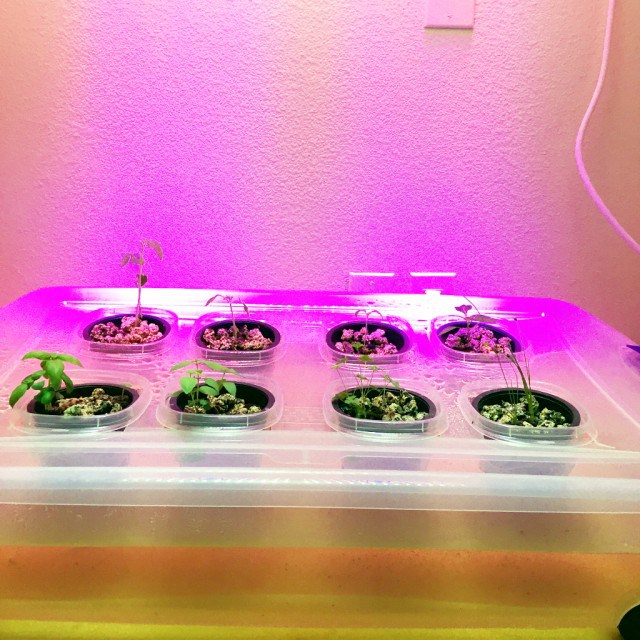







This started out well enough but didn’t end well. I don’t think the lights were working. The plants were thin and spindly.
This seems to be the year hydroponics goes mainstream. I started out with a AeroGrow Ultra LED hydroponics garden about a month ago. I was so impressed I decided to try something a bit bigger. This is my first attempt at growing tomatoes indoors.
So far so good. I wasn’t convinced the tomato plant was in fact a tomato so I restarted that with fresh seeds. Despite my constant tinkering everything seems to be coming along nicely.
I wasn’t happy with the way the tomatoes were doing and they were the main reason for growing hydroponics. Trying a tomato in the library which is very sunny using semi-hydroponics and replanted the herbs, largest tomato and pepper here in semi-hydroponics.
I found LED lights on eBay, there is a large selection of them, many quite cheap. Watch the wavelengths on the lights: the plants require 470nm, 612nm, 660nm. The blue helps the leaves and plant to grow, the red the flowers. Also watch the amount of light given off, if the LEDs are too cheap they are probably not very bright. Mix in some white lights so it will look nice. Mounting the lights turned out to be a bit of a challenge. I put hooks in the top and hooked the loops on the plants into the hooks. They are very bright so you’ll want something to keep them shaded from eyesight.
The plastic container came from Walmart as did the plastic pots, those are just cheap food storage containers. I drilled the holes in the top of the storage container to rest the pots in and holes in the pots to let water in and roots grow out.
Note that the water is only covering the bottom inch of the pots. The roots need air too. Be sure to leave an air gap between the top of the container and your water level.
The air pump was left over from an aquarium, you need to add air to the water. I purchased aquarium tubing to run from the pump into the container along with a splitter so I’d have two hoses blowing air bubbles. The hoses need something to weigh down the tubing otherwise they just float at the top and doesn’t put any air into the water. I used some left over nuts from a plumbing repair. Air stones were later added to help create more bubbles. According to the forums on hydroponics the more bubbles the better.
I planted the seeds in the expandable peat pots you find in most garden centers every spring for starting seeds.
The rock around peat pots ( to help keep the peat from dissolving into the water and hold the plant upright ) is aquarium rock. Most growers use coconut coir, easily found online. I already had the peat pots and aquarium rock in the garage.
Fertilizer. This is extremely important in hydroponics and there are many fertilizers that are designed for hydroponic gardens. They need to contain the 3 main nutrients: nitrogen, potassium and phosphorus, the secondary nutrients: calcium, magnesium and sulfur as well as the micro nutrients: boron, copper, iron, chloride, manganese, molybdenum and zinc. I’m using the Miracle Grow fertilizer for the LED garden right now. I ordered some Dyna-Gro to try. This was the only company on Amazon that listed the nutrients and % on the label. If you don’t see a list don’t buy the fertilizer.
pH: Plants take up nutrients easier at lower pH levels ~6.0-6.5. My tap water runs about 8.5. I’m using white vinegar to lower the pH, about a ml per gallon takes it down to 6.0. I had some test strips hanging around the house from various fish tanks, they work fine, you can also purchase a pH meter to test your water.
Automation: The air pump runs only at night so I don’t have to hear it, the lights run 16 hours during the day, there are several 24 hour timers for about $4/ at any hardware store.
Good starting places:
How to build indoor hydroponic gardens using IKEA storage boxes
Growing tomatoes hydroponically
Increasing sugar concentration in tomatoes
Growing Plants without Soil ( this is one of the first books written on hydroponics in the early 1920s)
In the news:
Scientists harvest Antarctic greenhouse vegetables
You must be logged in to post a comment.